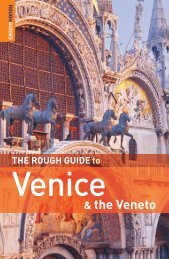Create successful ePaper yourself
Turn your PDF publications into a flip-book with our unique Google optimized e-Paper software.
It’s easy to understand why <strong>the</strong> people <strong>of</strong> Dubrovnik are proud<br />
<strong>of</strong> <strong>the</strong>ir city – it just takes one look. It takes a little more effort,<br />
however, to understand how deeply this pride runs, and how<br />
many, how varied and how rich and justified are <strong>the</strong> reasons<br />
for this pride. And, thank goodness, it manifests itself in a<br />
way that is very easy to love: <strong>the</strong> people <strong>of</strong> Dubrovnik are<br />
known for <strong>the</strong>ir gallantry and hospitality. It’s not an empty<br />
or boastful pride.<br />
Why does <strong>the</strong> city look <strong>the</strong> way it does? Why all those walls<br />
and bastions? It was first <strong>of</strong> all a refugee colony for <strong>the</strong> people<br />
<strong>of</strong> Epidaurum (today’s Cavtat), who fled from invading Avar<br />
and Slav tribes. At that time <strong>the</strong> land south <strong>of</strong> Stradun, as <strong>the</strong><br />
main thoroughfare through <strong>the</strong> Old Town is popularly called,<br />
was an island, <strong>of</strong>fering some protection from attack, but,<br />
<strong>of</strong> course, <strong>the</strong> walls began to rise giving those first fearful<br />
citizens <strong>the</strong>ir shelter.<br />
That was in <strong>the</strong> 7th century. At that time, <strong>the</strong>se lands were<br />
under <strong>the</strong> protection <strong>of</strong> Byzantium. Following <strong>the</strong> Crusades,<br />
Venice took over, and <strong>the</strong>n <strong>the</strong> Croatian-Hungarian kingdom.<br />
But in <strong>the</strong> 14th century, by <strong>the</strong> force <strong>of</strong> skilled diplomacy, <strong>the</strong><br />
nobles <strong>of</strong> Dubrovnik bargained <strong>the</strong>ir freedom, and this became<br />
a city-state which flourished for four centuries, maintaining<br />
independence from feared invaders such as <strong>the</strong> Turks, and,<br />
indeed, cultivating pr<strong>of</strong>itable relations with <strong>the</strong>m.<br />
The skill <strong>of</strong> <strong>the</strong> people <strong>of</strong> Dubrovnik in trade and in many o<strong>the</strong>r<br />
areas led to this tiny city state, <strong>the</strong>n known as <strong>the</strong> Republic <strong>of</strong><br />
Ragusa, becoming such a powerful force in <strong>the</strong> Adriatic that<br />
<strong>dubrovnik</strong>.inyourpocket.com<br />
introduCing <strong>dubrovnik</strong><br />
www.inyourpocket.com<br />
it seriously rivalled Venice’s dominance in <strong>the</strong> region. And<br />
during <strong>the</strong> heyday <strong>of</strong> <strong>the</strong> city’s development, art and culture<br />
flourished, leading to a love for harmony in one’s surroundings,<br />
a love <strong>of</strong> music, and a love <strong>of</strong> literature which much shaped<br />
<strong>the</strong> language <strong>of</strong> Croatian that we can hear today.<br />
This love <strong>of</strong> beauty is visible with every step in <strong>the</strong> Old Town,<br />
this living <strong>museum</strong> and famous World Heritage site. It can<br />
be seen in <strong>the</strong> galleries, on <strong>the</strong> <strong>the</strong>atre stages, and in its<br />
annual culmination at <strong>the</strong> Dubrovnik Summer Festival, in 2010<br />
held for <strong>the</strong> 61st time. It can also be heard – this is a city <strong>of</strong><br />
music too, <strong>of</strong> classical music, but also taking care <strong>of</strong> <strong>the</strong> folk<br />
vernacular <strong>of</strong> <strong>the</strong> coast and hinterland.<br />
Beauty is only skin deep, and this will to harmonise also<br />
manifested itself in a ra<strong>the</strong>r liberal political system which, for<br />
example, abolished slavery at a very early stage (1418). And<br />
alongside this respect for humanitarian concerns naturally<br />
came, <strong>the</strong> love <strong>of</strong> freedom. That’s why you’ll so <strong>of</strong>ten see<br />
<strong>the</strong> word “Libertas” emblazoned on everything from flags to<br />
<strong>the</strong> sides <strong>of</strong> buses.<br />
It’s hard to believe that this miraculous freedom <strong>of</strong> <strong>the</strong> tiny<br />
Republic <strong>of</strong> Ragusa, and this economic and political might<br />
lasted all <strong>the</strong> way to <strong>the</strong> beginning <strong>of</strong> <strong>the</strong> 19th century when<br />
<strong>the</strong> Dubrovnik nobles were tricked by Napoleon to letting his<br />
armies into <strong>the</strong> city in 1806. So it’s no surprise that <strong>the</strong> sense<br />
<strong>of</strong> individuality and collective pride is still so strong. It results,<br />
happily for visitors, in a very unique, visible and well-preserved<br />
culture that’s a joy to uncover.<br />
Winter 2011/2012<br />
7







